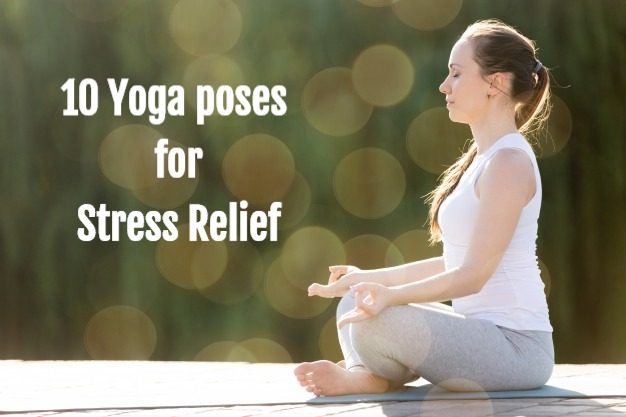In today’s fast-paced world, stress has become an unavoidable part of our lives. Whether it’s due to work, relationships, or other life pressures, stress can take a toll on our mental and physical well-being. Fortunately, practicing yoga can be a powerful tool to help alleviate stress and promote relaxation. By combining gentle movements with deep breathing and mindfulness, yoga can help calm the mind, reduce tension in the body, and restore a sense of balance and tranquility. In this blog post, we’ll explore 10 soothing yoga poses that are perfect for stress relief.
- Child’s Pose (Balasana):
-
- Begin by kneeling on the floor with your big toes touching and knees spread apart.
- Lower your torso between your thighs and extend your arms in front of you, resting your forehead on the mat.
- Hold for several breaths, allowing your body to relax and release tension in the back, shoulders, and hips.

- Cat-Cow Stretch:
-
- Start on your hands and knees with your wrists aligned under your shoulders and knees under your hips.
- Inhale as you arch your back, lifting your chest and tailbone towards the ceiling (Cow Pose).
- Exhale as you round your spine, tucking your chin to your chest and drawing your belly button towards your spine (Cat Pose).
- Flow between Cat and Cow Pose for several breaths, syncing movement with breath to release tension in the spine.

- Downward-Facing Dog (Adho Mukha Svanasana):
-
- Begin on your hands and knees, then lift your hips towards the ceiling, straightening your arms and legs.
- Press your palms and heels into the ground, creating length in the spine and legs.
- Hold for a few breaths, focusing on deep inhales and exhales to calm the mind and stretch the entire body.

- Standing Forward Fold (Uttanasana):
-
- Stand with your feet hip-width apart and hinge at the hips to fold forward, bringing your chest towards your thighs.
- Let your head hang heavy and grab opposite elbows, allowing gravity to gently stretch the spine and hamstrings.
- Take slow, deep breaths, feeling the release of tension in the back and neck.

- Seated Forward Bend (Paschimottanasana):
-
- Sit on the floor with your legs extended in front of you.
- Inhale to lengthen your spine, then exhale to fold forward from the hips, reaching towards your feet.
- Keep your back straight and avoid rounding the spine excessively. You can use a strap around your feet if needed.
- Hold for several breaths, feeling the stretch in the hamstrings and lower back.

- Bridge Pose (Setu Bandhasana):
-
- Lie on your back with your knees bent and feet hip-width apart.
- Press into your feet to lift your hips towards the ceiling, engaging your glutes and thighs.
- Interlace your hands under your back and press your arms into the ground to lift your chest towards your chin.
- Hold for a few breaths, opening the chest and releasing tension in the back.

- Legs-Up-the-Wall Pose (Viparita Karani):
-
- Sit with one side of your body against a wall.
- Swing your legs up onto the wall as you lie back, bringing your hips as close to the wall as comfortable.
- Rest your arms by your sides with palms facing up and close your eyes.
- Stay in this pose for several minutes, allowing the gentle inversion to calm the nervous system and promote relaxation.

- Corpse Pose (Savasana):
-
- Lie on your back with your legs extended and arms by your sides, palms facing up.
- Close your eyes and allow your body to completely relax into the mat.
- Focus on your breath, allowing each inhale to bring a sense of calm and each exhale to release tension.
- Stay in Savasana for at least 5-10 minutes, letting go of any thoughts or worries.

- Seated Meditation:
-
- Find a comfortable seated position, either cross-legged on the floor or in a chair with your feet flat on the ground.
- Close your eyes and bring your attention to your breath, allowing it to become slow and steady.
- Notice any thoughts or sensations that arise, but gently bring your focus back to the breath whenever the mind wanders.
- Practice meditation for 5-10 minutes or longer, depending on your preference.

- Alternate Nostril Breathing (Nadi Shodhana):
-
- Sit comfortably with your spine tall and shoulders relaxed.
- Use your right thumb to close your right nostril and inhale through your left nostril.
- Close your left nostril with your ring finger, then release the right nostril and exhale.
- Inhale through the right nostril, close it with your thumb, and exhale through the left nostril.
- Continue this alternating pattern for several rounds, focusing on the rhythm of your breath and the calming effect it has on the mind.

You may also Like: Beginner’s Guide to Strength Training: Building a Strong Foundation
Unlock Your Fitness Potential with High-Intensity Interval Training (HIIT)

